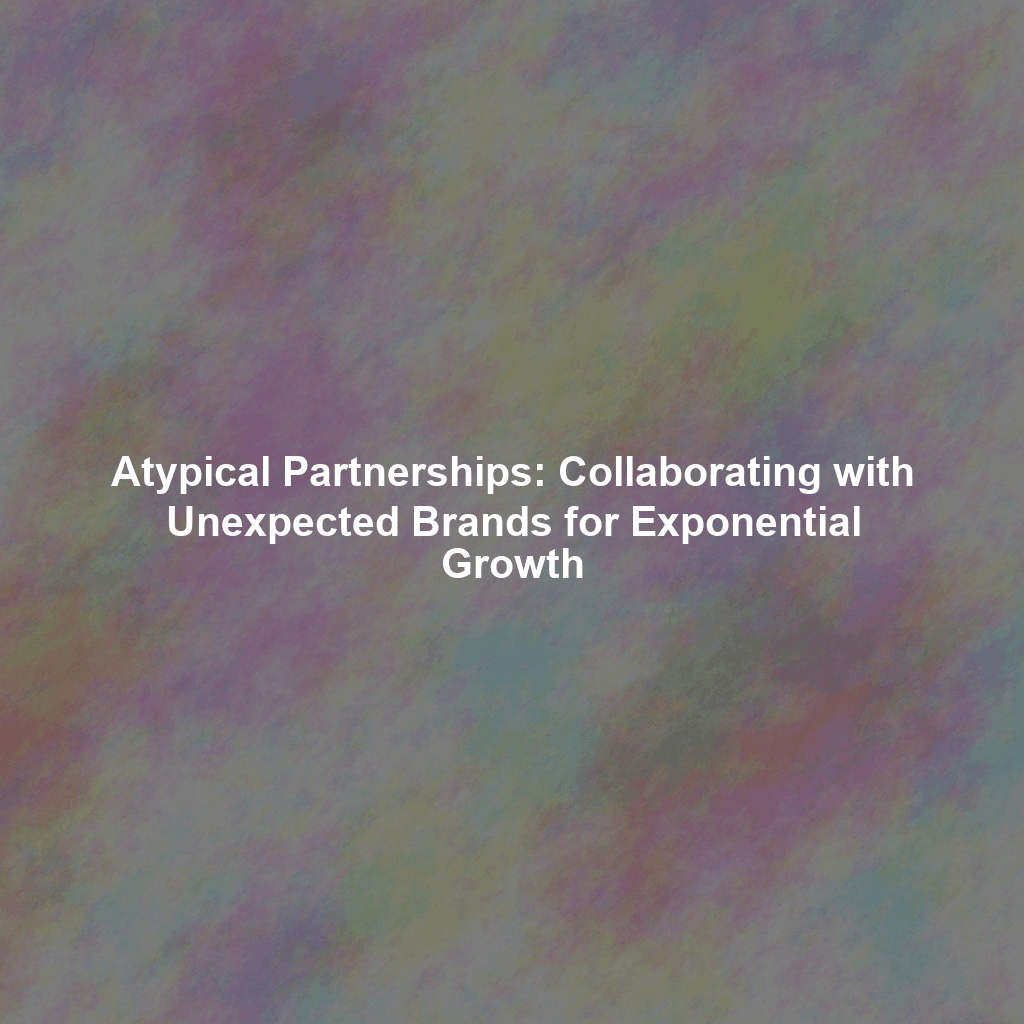Why Go Weird? The Power of Unconventional Collaboration
Why stray from the familiar? Because comfort breeds complacency, and complacency leads to stagnation. Unconventional partnerships offer a potent cocktail of benefits:
- Exposure to New Audiences: Tapping into a completely different demographic that you might never reach otherwise.
- Increased Brand Awareness: The sheer novelty of the collaboration creates buzz and gets people talking.
- Enhanced Brand Perception: Associate your brand with positive qualities from the partner brand, even if those qualities seem unrelated on the surface.
- Creative Content Opportunities: The unusual nature of the partnership sparks creativity and opens doors for unique and engaging content.
- Competitive Advantage: You’re doing something your competitors aren’t – setting you apart and establishing yourself as an innovator.
Brainstorming the Unthinkable: Unleashing Your Inner Mad Scientist
Okay, so you’re sold on the idea. But where do you even begin? Here’s a structured approach to brainstorming unconventional partnerships:
Define Your Objectives: What Are You Trying to Achieve?
Before you even think about potential partners, clarify your goals. Are you aiming to increase brand awareness, generate leads, drive sales, or reposition your brand? Knowing your objective will help you narrow down the possibilities and choose a partnership that aligns with your overall strategy.
Identify Your Brand Values and Personality: What Do You Stand For?
A successful partnership, even an unconventional one, needs to resonate with your core identity. What are your brand’s key values? What’s your personality like? Knowing this will help you identify potential partners who, despite their differences, share a common thread with your brand.
Think Outside the Box: Embrace the Absurd
This is where the fun begins! Start listing brands that are seemingly unrelated to yours. Think about industries that are diametrically opposed or target completely different demographics. Don’t censor yourself – write down every idea that comes to mind, no matter how outlandish it may seem. For example:
- A luxury car brand partnering with a budget airline: A surprising contrast could highlight the value proposition of both – accessible luxury versus high-end comfort.
- A high-end fashion house collaborating with a fast-food chain: Imagine limited-edition burger wrappers designed by renowned artists. Pure hype!
- A funeral home partnering with a dating app: Okay, this sounds morbid, but a campaign focused on “living life to the fullest” could be surprisingly impactful.
Find the Common Ground: Where Do Your Worlds Intersect?
Once you have a list of potential partners, start looking for areas of overlap. This could be a shared target audience (even if they’re being targeted for different needs), a shared value (e.g., sustainability, innovation, community), or a shared interest (e.g., music, sports, art). The key is to find a connection, however tenuous, that can serve as the foundation for the partnership.
Consider the Logistics: Can You Actually Pull It Off?
Even the most brilliant idea is useless if it’s not feasible. Can you realistically work with the potential partner? Do you have the resources to execute the partnership effectively? Consider factors such as budget, timeline, and legal considerations before committing to a partnership.
Real-World Examples of Atypical Partnerships That Nailed It
- Crocs and Balenciaga: High fashion meets comfort footwear? It shouldn’t work, but it did! The collaboration generated massive buzz and repositioned Crocs as a fashion-forward brand.
- Taco Bell and Forever 21: Fast food-themed clothing? Why not! This partnership tapped into the cultural relevance of Taco Bell and appealed to a young, fashion-conscious audience.
- BMW and Louis Vuitton: Luxury cars and luxury luggage – a natural fit in some ways, but also a bold statement about exclusivity and travel.
- Spotify and AncestryDNA: In a unique campaign, users could connect their DNA results to generate customized playlists based on their heritage. It was weird, viral, and deeply personal. (Adweek)
- LEGO and Stranger Things: One is a classic toy brand; the other is a nostalgic Netflix horror series. Together, they launched a line of “upside-down” sets that delighted fans across generations.
Behind the Scenes: Lessons From Real Marketers
At a recent branding conference in Austin, a CMO of a mid-sized fintech firm shared a fascinating story. Their team had partnered with a local comic book convention. Why? Because their product was dry—but their audience skewed young and geeky. They set up a “Loan Hero” booth where attendees could get their FICO score analyzed by cosplayers dressed as financial superheroes. The campaign delivered a 28% increase in qualified leads and got picked up by regional news.
Another example comes from a sustainable cleaning product startup. Instead of sponsoring a food blogger (typical), they collaborated with a well-known tattoo artist to design biodegradable packaging inspired by traditional ink styles. The result? Massive appeal on Instagram, and a 62% increase in their Gen Z customer base within three months.
What to Avoid: Pitfalls of Weird for Weird’s Sake
As exciting as atypical partnerships can be, they’re not without risk. Here’s what to watch out for:
- Brand Misalignment: If your audiences or values clash too much, it can lead to confusion or backlash.
- Execution Gaps: Sometimes the idea is strong, but the execution falls flat—leading to a forgettable or cringe-worthy campaign.
- Overshadowing: If your partner is significantly more recognizable, your brand may become a footnote.
- Legal Confusion: Licensing, intellectual property rights, and co-marketing agreements can be more complex than you think.
How to Pitch a Weird Partnership Without Getting Laughed Out of the Room
Let’s be real—internal stakeholders or cautious clients might balk at bold ideas. Here’s how to win them over:
- Lead with Data: Cite case studies and statistics. Refer to sources like Statista or Pew Research to ground your ideas in reality.
- Prototype the Concept: Mock up visuals or a small test campaign. Show don’t just tell.
- Estimate ROI: Use conservative modeling to forecast exposure, leads, or media mentions.
- Tell a Story: Frame the partnership in narrative form. How does it begin? What’s the twist? What does success look like?
The Takeaway: Embrace the Unexpected, Reap the Rewards
Unconventional brand partnerships aren’t just about being weird for the sake of being weird. They’re about strategically leveraging unexpected collaborations to reach new audiences, generate buzz, and ultimately, drive growth. When done right, they leave a lasting impact—not just for clicks and giggles, but for real revenue, relevance, and reputation.
“The best marketing doesn’t feel like marketing.” – Tom Fishburne, creator of Marketoonist
So, go ahead. Get a little weird. You might just discover your brand’s next big leap hiding in the most unexpected place.
 Skip to content
Skip to content

